LSAT 104 – Section 4 – Question 10
LSAT 104 - Section 4 - Question 10
December 1998You need a full course to see this video. Enroll now and get started in less than a minute.
Target time: 0:50
This is question data from the 7Sage LSAT Scorer. You can score your LSATs, track your results, and analyze your performance with pretty charts and vital statistics - all with a Free Account ← sign up in less than 10 seconds
| Question QuickView |
Type | Tags | Answer Choices |
Curve | Question Difficulty |
Psg/Game/S Difficulty |
Explanation |
|---|---|---|---|---|---|---|---|
| PT104 S4 Q10 |
+LR
| Flaw or descriptive weakening +Flaw Conditional Reasoning +CondR Causal Reasoning +CausR | A
0%
B
98%
168
C
0%
154
D
1%
149
E
1%
163
|
124 133 141 |
+Easiest | 147.438 +SubsectionMedium |
Summarize Argument: Phenomenon-Hypothesis
The author concludes that Fred’s computer mouse must have been unplugged. He supports this by saying that unplugging the mouse from a computer causes all programs that require the mouse to become unusable. He then notes that a software program on Fred’s computer that requires the mouse has become unusable.

Identify and Describe Flaw
This is the flaw of mistaking sufficiency for necessity. The author treats “unplugging the mouse” as necessary for “the program becoming unusable.” But according to his argument, “unplugging the mouse” is sufficient, not necessary.
In other words, the argument overlooks the possibility that Fred’s program could become unusable without his mouse becoming unplugged.
A
It contains a shift in the meaning of “unusable” from “permanently unusable” to “temporarily unusable.”
This is the cookie-cutter flaw of “equivocation.” But the author doesn’t use multiple meanings of the word “unusable” throughout his argument. He simply uses it to mean that a software program has stopped working.
B
It treats an event that can cause a certain result as though that event is necessary to bring about that result.
Unplugging the mouse can cause a program to become unusable, but the author assumes that it’s necessary to bring about that result. In other words, the conclusion mistakenly treats “unplugging the mouse” as a necessary condition, while in the premises, it’s merely sufficient.
C
It introduces information unrelated to its conclusion as evidence in support of that conclusion.
The author never introduces unrelated information as evidence. His evidence is related to his conclusion, but he mistakes the sufficient condition for a necessary condition.
D
It attempts to support its conclusion by citing a generalization that is too broad.
The argument cites a specific scenario about Fred, not a broad generalization.
E
It overlooks the possibility that some programs do not require a peripheral component such as a mouse.
The author is only addressing Fred’s software program that does require a mouse. Presumably other programs don’t require a mouse, but those programs aren’t relevant to the argument.
Take PrepTest
Review Results
LSAT PrepTest 104 Explanations
Section 1 - Logical Reasoning
- Question 01
- Question 02
- Question 03
- Question 04
- Question 05
- Question 06
- Question 07
- Question 08
- Question 09
- Question 10
- Question 11
- Question 12
- Question 13
- Question 14
- Question 15
- Question 16
- Question 17
- Question 18
- Question 19
- Question 20
- Question 21
- Question 22
- Question 23
- Question 24
- Question 25
- Question 26
Section 2 - Reading Comprehension
- Passage 1 – Passage
- Passage 1 – Questions
- Passage 2 – Passage
- Passage 2 – Questions
- Passage 3 – Passage
- Passage 3 – Questions
- Passage 4 – Passage
- Passage 4 – Questions
Section 3 - Reading Comprehension
- Passage 1 – Passage
- Passage 1 – Questions
- Passage 2 – Passage
- Passage 2 – Questions
- Passage 3 – Passage
- Passage 3 – Questions
- Passage 4 – Passage
- Passage 4 – Questions
Leave a Reply
You must be logged in to post a comment. You can get a free account here.